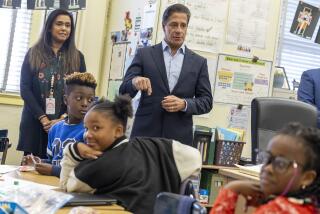L.A. Catholic schools to add 20 days to academic year
- Share via
As public school students in Los Angeles adjust to a shorter academic year, Catholic school pupils face a different sort of transition. Beginning this fall, most elementary schools in the Roman Catholic Archdiocese of Los Angeles will add 20 days to their schedules, making their school year one of the longest in the United States.
In announcing the expansion to a 200-day calendar, Cardinal Roger Mahony insisted Thursday that the archdiocese was not trying to gain a competitive advantage over the Los Angeles Unified School District, which has cut its school year to 175 days this year. He said the Catholic schools which serve 52,000 elementary and middle school children in three counties, were simply trying to step up their performance to ensure that students would become globally competitive.
“We’re not in competition with LAUSD, nor is this aimed at LAUSD,” the cardinal said during a news conference at Nativity School in South Los Angeles. “What we’re trying to do is focus on the group that we’re entrusted with, and we believe that more time in the classroom is beneficial to the students.”
National studies have long pointed to the benefits of a longer school year, and education reformers have noted that U.S. schools have a shorter school year than their counterparts in other developed countries. Despite that, few schools have attempted to significantly lengthen their instructional year, largely because of the increased cost.
Los Angeles Unified Supt. Ramon C. Cortines said he would lengthen the public school year “in a minute” if he had enough money. “I think it’s wonderful for the students,” he added.
“This is a pretty bold action,” said Chris Gabrieli, chairman of the National Center on Time and Learning, a Boston-based organization that advocates a longer school year and day. He said he could think of no school system as large as the one run by the Los Angeles Archdiocese that had attempted to significantly lengthen its academic year.
“It’ll be an important experiment to watch,” he said.
Probably the largest school system to operate on an extended calendar is that run by the KIPP charter school group, which operates 99 schools across the country, including five in Los Angeles. The KIPP year varies by school, with many staying open for more than 200 days. They also have a significantly longer school day than most schools, and have been praised for their academic achievement.
With 210 elementary schools spread across Los Angeles, Ventura and Santa Barbara counties, the archdiocese runs one of the largest school systems in California, larger than the public school districts in San Francisco or Sacramento. It has earned accolades for operating well-run, academically rigorous schools that serve many low-income students.
There also are 50 Catholic high schools in the archdiocese serving some 30,000 students. They are not included in the schedule change.
The expansion was announced jointly by Mahony and Coadjutor Archbishop Jose Gomez, who will succeed him in a month. It comes as Catholic schools nationally are coping with serious setbacks. Large settlements in sexual abuse lawsuits have left the church struggling to maintain financial support for schools in some jurisdictions. In others, the schools have been hurt by a decline in the Catholic population.
Both Mahony and Kevin Baxter, superintendent of elementary schools for the archdiocese, said most extra costs for the longer school year would be borne by individual schools, with help from the nonprofit Catholic Education Foundation and the archdiocese’s Together in Mission fundraising arm. Baxter said he was also seeking additional foundation support.
Tuition, which is charged on a monthly basis, will increase by one month. Amounts range from about $200 a month at schools in very poor neighborhoods to about $800 a month in more affluent areas, Baxter said. He said the archdiocese was committed to helping any families that couldn’t afford the higher cost.
“We want to ensure that no family leaves any Catholic school because of the increase in tuition,” he said.
Teachers will receive a 10% raise for the extra month of work. Most schools are expected to adopt the new schedule in the fall, with the rest following in the fall of 2012.
A few schools, including Nativity, have already gone to a longer school year. Nativity switched eight years ago and has seen its students thrive, according to its principal, Sister Judy Flahavan. By the time students finish eighth grade, she said, they are working at a ninth-grade level in most subjects and an 11th-grade level in English. With 324 students, 95% of them Latino, the school serves a low-income population that includes many nonnative English speakers, she said.
Antonio Felix, a teacher who became the school’s director of marketing and development this year, said one key to its success has been its relatively short summer vacation, from late June until mid-August. “We’re not just giving them more time in school to learn,” he said. “We’re giving them fewer days out of school to forget.”
Juanita Vasquez, the mother of a fourth-grader and the president of Nativity’s parent committee, said most parents like the longer school year, both because their children learn more and because they know their children are safe in school.
She said she doesn’t find the extra month of tuition — $205 a month at Nativity — excessive. “I’d rather spend it on my kids’ education than on other things,” she said.
mitchell.landsberg@latimes.com
More to Read
Sign up for Essential California
The most important California stories and recommendations in your inbox every morning.
You may occasionally receive promotional content from the Los Angeles Times.













